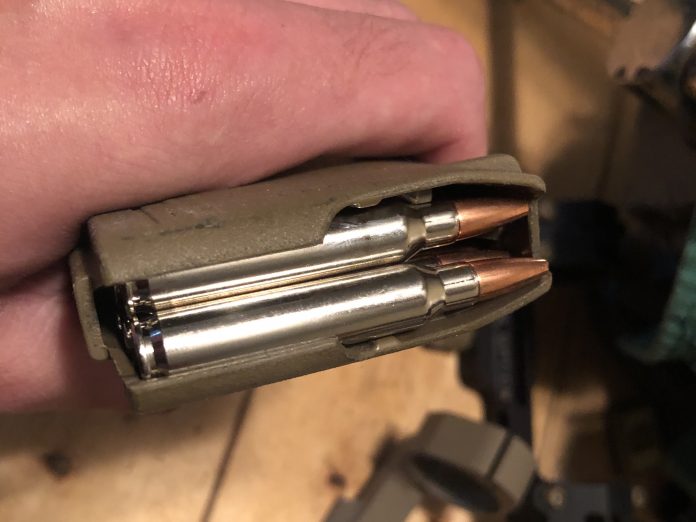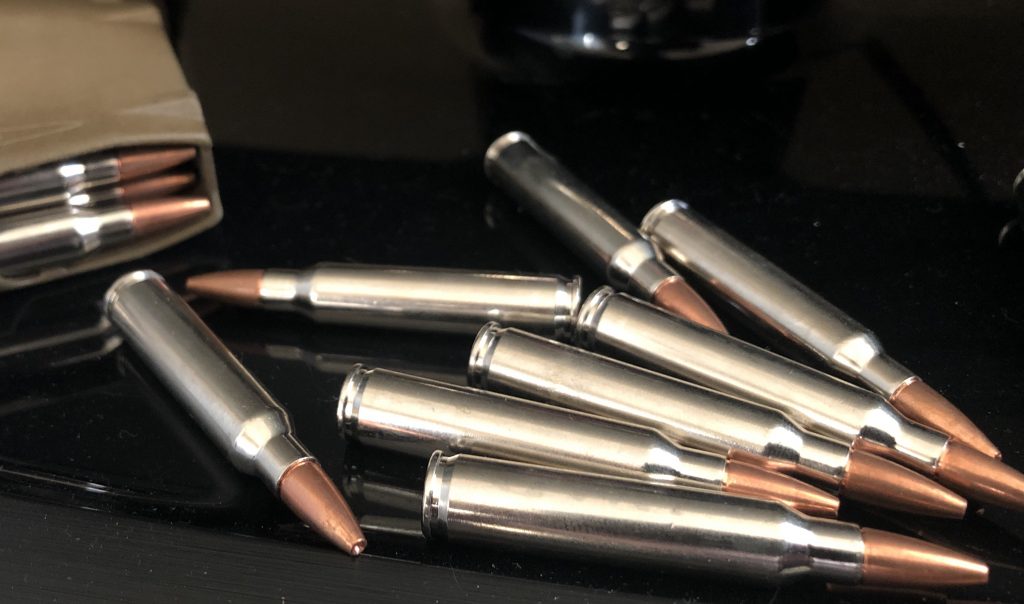
Okay no, no vampire or werewolf increased effectiveness here, despite being in spooky season. No, these silver sheened rounds from Sig Sauer’s ammunition line up are for a different series of predators, both two and four legged. The ‘silver bullet’s’ are Sig’s Elite Copper Hunting HT’s and might be just the round you are looking for.
223REM, 60GR, ELITE HUNTING HT

Many of you may recall how my Sig Sauer 77gr review went. If not, go ahead and click that link. But in short I started the evaluation earlier than intended because I grabbed my loaded 77gr magazine while shooting from the bench rapidly and shot the high performing and far more expensive OTM ammo down range behind some bulk bought M193.
There is little visual difference between the OTM and 55gr practice rounds I was shooting and down range they went. Oops. Live and learn, and look at some visually distinct ammo. Enter 60gr HT.
The HT Anatomy
The Elite Copper Hunting line are made around an all copper projectile. No lead, this has become a requirement in several jurisdictions to use the ammo for hunting, if at all. On top of being a “green” round by having a non-lead bullet the copper itself is bonded in such a way to maximize its expansion in soft tissue and leave effective permanent wound cavities. This combined with the high speed of the 5.56/.223 Remington rounds makes for an incredible terminal package.
The projectile is seated in a nickel plated case. The “silver bullets” are copper seated in nickel. That nickel case gives the ammunition a greater environmental seal. It resists moisture incursion and exposure degradation better than brass alone. Important when outside, when stored in sub-optimal conditions, and when carried on or near your person.
You sweat. I sweat. It gets gross. Clean your EDC and you’ll understand. That harsh external environment is leading reason a lot of EDC hollow point ammunition uses nickel casings. The same logic applies to these rounds.
Visually Distinct
The nickel casings have a secondary benefit that you and I can utilize to keep your defense and performance ammo seperated from your practice ammo. The rounds are strikingly visually distinct from regular brass case 5.56/.223 and, just like your magazine of hollow points for your carry gun, making it an easy at a glance check.
Why Solid Copper?
Lead free projectiles have become mandatory for hunting in several locations around the nation, this satisfies that requirement.
But, from a performance standpoint, let us turn to a recent military ammunition development that was being run parallel to M855A1. The Special Operations Science and Technology or SOST, the Marine Corps’ own silver bullet.
The History of SOST
Following early engagements in Afghanistan and Iraq, U.S. Special Operations Forces reported that M855 ammunition used in M4A1 rifles was ineffective. In 2005, the Pentagon issued a formal request to the ammunition industry for “enhanced” ammunition. The only business that responded was the Federal Cartridge Company, owned by Alliant Techsystems. Working with the Naval Surface Warfare Center Crane Division, the team created performance objectives for the new ammo: increased consistency from shot to shot regardless of temperature changes, accuracy out of an M4A1 better than 2 minute of angle (1 inches at 100 yards, 3.9 inches at 300 yards), increased stopping power after passing through “intermediate barriers” like walls and car windshields, increased performance and decreased muzzle flash out of shorter barrel FN SCAR rifles, and costs close to the M855. The first prototypes were delivered to the government in August 2007. Increased velocity and decreased muzzle flash were accomplished by the type of powder used. The design of the bullet was called the Open Tip Match Rear Penetrator (OTMRP). The front of it is an open tip backed up by a lead core, while the rear half is solid brass. When the bullet hits a hard barrier, the front half of the bullet crushes against the barrier, breaking it so the penetrating half of the bullet can go through and hit the target. With the lead section penetrating the target and the brass section following, it was referred to as a “barrier blind” bullet.[48][120]
Officially designated the Mk318 Mod 0 “Cartridge, Caliber 5.56mm Ball, Carbine, Barrier”, and called SOST (Special Operations Science and Technology) ammunition, the 62-grain bullet fragments consistently, even out of a 10.5 in barrel. The lead portion fragments in the first few inches of soft tissue, then the solid copper rear penetrates 18 in of tissue (shown though ballistic gelatin) while tumbling. Out of a 14″ in barrel, the Mk318 has a muzzle velocity of 2,925 ft/s (892 m/s).[48][120]
In February 2010, the U.S. Marine Corps adopted the Mk318 for use by infantry. To be fielded by an entire branch of the military, the round is classified as having an “open-tip” bullet, similar to the M118LR 7.62 NATO round. The SOST bullet uses a “reverse drawn” forming process. The base of the bullet is made first, the lead core is placed on top of it, and then the jacketing is pulled up around the lead core from bottom to tip. Conventional, and cheaper, bullets are made with the method of the jacket drawn from the nose to an exposed lead base. The reverse drawn technique leaves an open tip as a byproduct of the manufacturing process, and is not specifically designed for expansion or to affect terminal ballistics. The Pentagon legally cleared the rounds for Marine use in late January. The Marines fielded the Mk318 gradually and in small numbers. Initial studies showed that insurgents hit by it suffered larger exit wounds, although information was limited. SOST rounds were used alongside M855 rounds in situations where the SOST would be more effective.[48][120][121] In July 2010, the Marines purchased 1.8 million M855A1 Enhanced Performance Rounds, in addition to millions of Mk318 rounds in service, as part of its effort to replace its M855 ammo.[122] As of May 2015, Marine combat units still deployed with a mixture of both SOST and M855 rounds.[123]
As the issue of environmentally friendly ammo grew, the Marines looked to see if the Mk318’s lead could be replaced while still meeting specifications. They found that by replacing the lead with copper and slightly stretching the jacket around to crimp the nose even more, the bullet’s ballistic coefficient increased. To avoid visual confusion with the Mk 262 round, the bullet was entirely nickel-plated for a silver color; the enhanced silver-colored copper jacketed, open tip match, 62-grain projectile was named the Mk318 Mod 1.[124]
If you are drawing parallels, you should be.
The principle difference between the 62gr Mk318 Mod 1 and the 60gr ECH HT are in the way the copper is bonded to expand or fragment. The Sig round is designed to crush into a larger wound channel causing mass where the Mk318 Mod 1 will fragment for the same desired interior effect.
Greater internal tissue damage to generate exsanguination, greater transfer of energy at high velocity for hydrostatic shock generation, and higher ballistic coefficients for improved accuracy and consistency. So for the field, or the homestead, Sigs a solid commercial variant of the solid copper solution.




